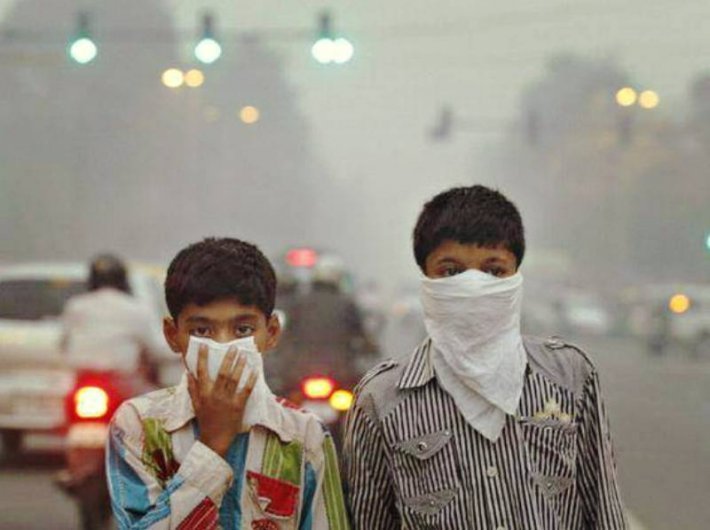A comprehensive study carried out by IIT Kanpur had spelt out the causes for air pollution in Delhi and had also provided remedial options
As the residents of Delhi and its adjoining satellite towns gasp for breath due to exceedingly high pollution levels, an IIT study that was submitted to the Delhi government in the beginning of this year had identified the factors that caused pollution and offered steps to tackle it. A proactive action could well have averted the present crisis.
The city of Delhi has a complex urban environment with respect to air pollution and faces severe air pollution of PM10, PM2.5 and NO2, said IIT Kanpur’s Comprehensive Study on Air Pollution and Green House Gases (GHGs) in Delhi which was submitted to the Delhi government in January 2016.
“The winter sources (% contribution given in parenthesis for PM10 - PM2.5) include: secondary particles (25 - 30%), vehicles (20 - 25%), biomass burning (17 – 26%), MSW (municipal solid waste) burning (9 - 8%) and to a lesser extent soil and road dust. It is noteworthy, in winter; major sources for PM10 and PM2.5 are generally the same,” said the study.
The study called for “an integrated pollution control approach in the region” to help improve the air quality. Based on the comprehensive source apportionment study, the sources of PM10 and PM2.5 contributing to ambient air quality are different in summer and winter.
“The summer sources (% contribution given in parenthesis for PM10 - PM2.5) include: coal and fly ash (37 - 26%), soil and road dust (26 – 27%), secondary particles (10 - 15%), biomass burning (7 - 12%), vehicles (6 – 9%) and MSW burning (8 – 7%).”
The study said that although sources contributing to summer and winter air pollution are different but the overall action plan should include control of all sources regardless of season.
It went on to say that air polluting sources are plenty and efforts are required for every sector/source. In addition, there is a need to explore various options for controlling air pollutants for increased emission in future.
On burning of Municipal Solid Waste (MSW), the study said that it is wide spread in Delhi and NCR, more frequent in winter. “A recent study by Nagpure et al. (2015) in Delhi has estimated 190 to 246 tons/day of MSW burning. The presence of chloride in the ambient air indicates that along with MSW, plastics and tyres burning could also be taking place in some areas. The estimated emissions are: 2000 kg/d of PM10 and about 1800 kg/d of PM2.5. MSW burning contributes to nearly 10% of PM10 and PM2.5 in ambient air in winters.”
It added that any form of garbage burning should be strictly stopped and monitored for its compliance. It will require development of infrastructure (including access to remote and congested areas) for effective collection of MSW and disposal at landfill site. The other viable option due to space constraint is to use Waste to Energy technology with effective flue gas control system to dispose of MSW.
Importantly, the study said that a complete ban on MSW burning can almost bring the emissions from this source to zero and one can see an improvement of 5-10 percent in air quality.
The study pointed out that vehicle emission and their contribution to ambient air concentration is the significant to PM10 and PM2.5 both in winter and summer. “In winter, on average vehicles can contribute 25% to PM2.5 and at certain locations this contribution could be above 35%. In summer, vehicular contribution is masked by other prominent sources. There is a significant contribution of diesel vehicles to PM10, PM2.5 and NOx”. Therefore, control measures have focused on advanced technological intervention for diesel vehicles.
Although Delhi is kerosene free and 90% of the households use LPG for cooking, the remaining 10% uses wood, crop residue, cow dung, and coal for cooking (Census-India, 2012). The study said that “LPG should be made available to remaining 10% households to make the city 100% LPG-fueled. This action is expected to reduce 55% of PM10 (3270 kg/d), 50% of PM2.5 (2829 kg/d) and 4% of NOx (635 kg/d) emissions from domestic sector. This reduction in emission will reduce the ambient air concentration by 4.4 µg/m3 and 3.6 µg/m3 in PM10 and PM2.5 respectively”.
Read: IIT Kanpur’s Comprehensive Study on Air Pollution and Green House Gases (GHGs) in Delhi
Also Read: Delhi govt’s measures to tackle pollution are too little too late: Greenpeace
